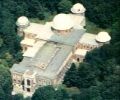Guided tour through the Kuffner Observatory
by Günther Wuchterl
Verein Kuffner Sternwarte, Vienna, Austria

The Kuffner Observatory, founded in 1884, hosts the DARKSKY 2008 meeting. The dome of the main building houses a double refractor for visual and photographic use, with apertures of 27 cm and 15.6 cm, respectively. Working on this instrument, Karl Schwarzschild discovered the reciprocity failure of photographic emulsions. The second dome houses a Heliometer, a special instrument for measuring stellar parallaxes by visual observation. With an aperture of 21.7cm and a focal length of 3 meters, this is the largest instrument of it's kind. Furthermore, the observatory houses a meridian and a vertical circle.
Weather permitting, observations with the historic instruments are planned.
Additional a guided tour through the "good quality illumination park" next to the observatory is planned.
Conference Dinner and "Großmugl at the Milky Way" excursion
by Restaurant Schillinger
Großmugl, Austria

Großmugl is an municipality including ten villages in Lower Austria, within the "Weinviertel" (well known for wine production), 40 km north of Vienna and with a population of about 1800 inhabitants. The elevation is 217 m (712 ft).
The Leeberg, Central Europe's largest hill grave, rises from the fields near Großmugl. The name of the village literally translates as "large steep hill" and refers to a nearby TUMULUS (locally known as the Leeberg). It is believed to have been built by the people of the Kalenderberg culture, probably around 600-500 B.C. This was a northeastern subgroup of the Hallstatt culture, with a generally somewhat poorer standard of living than the other coexisting subgroups of the eastern Hallstatt cultural area. The geographic position of the Leeberg is 48° 29.34'N/16°13.45'E.
With a diameter of 55 m and a remaining height of 16 m the Leeberg is the largest hill grave in Central Europe. Taking erosion into account, its original size can be estimated at about 18-20 m height and a base diameter of about 70 m. Because of its unusual size it has apparently discouraged tomb raiders and also the more recent efforts of "amateur archeologists." Although it is beyond doubt that this huge tumulus must be a powerful local chieftain's burial place, no serious attempt of scientific investigation of the Leeberg has been made by now.
North-east of the Leeberg you can find a remarkable place for stargazing. But we use another entrance, our "fairy footpath". It starts nearby our meeting-point, the vegetarian-vegan restaurant "Schillinger". Surprised?
We too! A vegetarian restaurant in a small village in the middle of nowhere, one-fifth are farmers, were the most of the inhabitants are old-established? But attention! If you drop in, perhaps the inn is jam-packed!
Accompany us on Saturday evening and you will gain two experiences:
Vegetarian-vegan food tasting fantastic and looking like …. You will see!
Additional, observations of the extraordinary firmament, presenting an unbelievable glace of the Milky Way, that near to a big capital city like Vienna. That's why we created the name "Großmugl at the Milky Way".
We started the first astro tourism project in Austria in cooperation with Großmugl. The community plans to adopt the ground with a wooden observation deck. The inn Schillinger plans to build up a little shop for astronomical stuff, books, some odds and sods, short-time rentals of telescopes and redlightening lamps. Members of the Verein Kuffner Sternwarte will help "building up a suite of instrumentation with a focus on anticipating the beauty of the night sky."
But particularly the gaze by unaided eye and the awe-inspiring firmament is the first choice.
Our goal is clear: to inspire as much people as possible to enjoy the amazing nightsky and to raise their awareness for unnecessary ambient light introduced into our natural environment.
Großmugl will protect the observing spot by shielding the lights and on the Saturday of our excursion --- as well as on "Stargazing-days" in the future --- all unnecessary ligths and the public streetlights will be turned off.
Guided tour trough the Vienna University Observatory
by Thomas Posch
Institute for Astronomy, University of Vienna, Austria

Inaugurated by Emperor Franz Josef I in 1883, the University Observatory still hosts the most important astronomical research and teaching institution of Austria. It combines - in a unique fashion - the beauty and representative architecture of the late 19th century with modern international research. A visit to the observatory will provide a historical overview of both science and architecture, a presentation of treasures from our rare book collection starting from the 15th century, including authors like Peuerbach, Copernicus, Kepler, Hevelius, Cellarius, Newton, and many others, and a chance to observe with the large 68cm-refractor, weather allowing.



